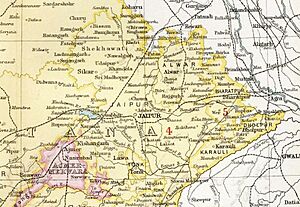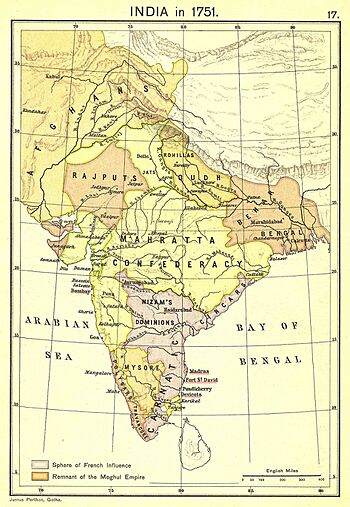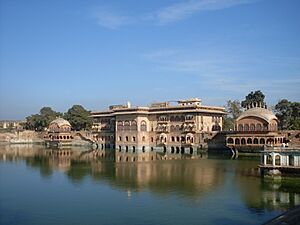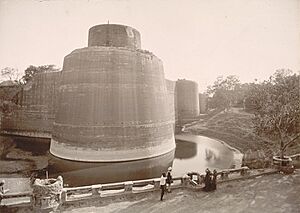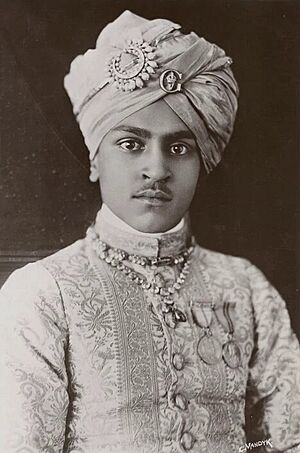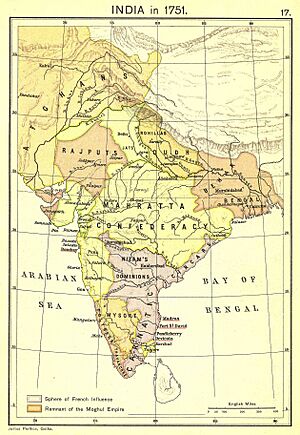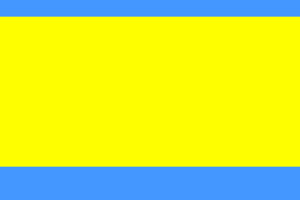Bharatpur State facts for kids
Quick facts for kids
Bharatpur State
|
|||||||||
|---|---|---|---|---|---|---|---|---|---|
| 1722–1947 | |||||||||
|
Bharatpur State in the Imperial Gazetteer of India
|
|||||||||
| Capital | Bharatpur | ||||||||
| Common languages | Braj Hindi |
||||||||
| Government |
|
||||||||
| Maharaja | |||||||||
|
• 1722–1756 (first)
|
Badan Singh | ||||||||
|
• 1929–1947 (last)
|
Brijendra Singh | ||||||||
| Historical era | Medieval India | ||||||||
|
• Established
|
1722 | ||||||||
|
• End of British seizuranity;
Accession to Dominion of India |
15 August 1947 | ||||||||
|
|||||||||
| Today part of | India · Rajasthan |
||||||||
Bharatpur State, also known as the Kingdom of Bharatpur, was an important Hindu kingdom in northern India. It was ruled by the Sinsinwar clan of the Jats. During the rule of King Suraj Mal (1755–1763), the state earned a lot of money.
Two famous buildings from this state are Lohagarh Fort and Deeg Palace.
Lohagarh Fort is a well-known fort in Bharatpur city, Rajasthan. Maharaja Suraj Mal built it in 1732 on an artificial island. It took eight years to finish. The fort's name, "Lohagarh," means "Iron Fort," showing how strong it was. British forces, led by Lord Lake, tried to capture it in 1805. Despite many attacks during the Siege of Bharatpur, they could not take it.
Deeg Palace is a beautiful palace located in Deeg, about 32 km from Bharatpur city. Maharaja Suraj Mal built it in 1730. It was a luxurious summer home for the rulers of Bharatpur State.
Contents
History of Bharatpur State
The Bharatpur State began because the Jats living near Delhi, Agra, and Mathura rebelled against the Mughals.
Early Rebellions and Foundation
The first revolt was led by Gokula, a local Jat leader, in 1669. Even though the Jats lost, the desire for freedom continued. In 1685, a second uprising started under RajaRam of Sinsini. This time, they used clever guerrilla warfare.
The Mughal emperor Aurangzeb asked Bishan Singh, a Rajput ruler, to stop the Jats. However, unrest among the Jats continued. In the early 1700s, Churaman took advantage of Mughal civil wars. He managed to remove the Rajputs and create an independent state. Rajaram also built a small fort at Sinsini, which was a key step for the kingdom.
Maharaja Suraj Mal's Rule
The most famous ruler of Bharatpur was Maharaja Suraj Mal. He captured the important Mughal city of Agra in 1761. Agra stayed under Bharatpur's control until 1774. After Maharaja Suraj Mal's death, other rulers like Maharaja Jawahar Singh and Maharaja Ratan Singh continued to rule over Agra Fort.
Battles and British Influence
In 1774, the Jats were defeated by the Mughal army led by Mirza Najaf Khan. He took back most of the Jat lands, including Agra and Aligarh.
In 1805, a war started between the British and the Holkars. Maharaja Ranjit Singh of Bharatpur helped the Holkar. The British surrounded the Bharatpur fort. After three months, Ranjit Singh made peace and signed a treaty. This made Bharatpur a princely state under British control.
Later, between December 1825 and January 1826, British troops led by Lord Combermere attacked Bharatpur's capital. On January 18, 1826, the fort was captured. After this siege, Bharatpur remained a princely state under British rule.
Maharaja Jashwant Singh of Bharatpur greatly helped the British during the Indian Rebellion of 1857. The British recognized his support.
Joining Independent India
In August 1947, Bharatpur State joined the newly independent Dominion of India. In 1948, it became part of the Matsya Union. Then, in 1949, it became part of the state of Rajasthan. Members of the ruling family are still involved in politics today.
Expansion and Military Power
How Big Was Bharatpur?
In the 1760s, the Kingdom of Bharatpur was at its largest. It covered a huge area, including parts of modern-day eastern Rajasthan, southern Haryana, western Uttar Pradesh, and Delhi. This included many districts like Agra, Aligarh, Alwar, and Mathura.
Bharatpur's Army
During the time of Maharaja Jawahar Singh, Bharatpur had a strong army. It included 25,000 foot soldiers (infantry), 15,000 horse riders (cavalry), and 300 cannons. They also had troops stationed in their forts.
Rulers of Bharatpur
Here are some of the important rulers of the Sinsinwar dynasty:
- Badan Singh (1722–1756): He was the first Raja of Bharatpur and founded the state. He built the Royal Palace and Gardens at Deeg.
- Maharaja Suraj Mal (1756–1763): Born in 1707, he was a very powerful ruler. He expanded the kingdom's borders and helped Maratha soldiers after the Third Battle of Panipat. He also built the famous Lohagarh Fort.
- Maharaja Sawai Jawahar Singh (1763–1768): He led the Battle of Delhi. He brought back important gates, like the Lohiya gate, to Lohagarh Fort.
- Maharaja Ranjit Singh (1776–1805): During his rule, the Jats lost some lands. He later fought against the British, successfully defending his fort for a long time.
- Jaswant Singh of Bharatpur (1853–1893): He was born in 1851. During his rule, Bharatpur helped the British government during the 1857 rebellion.
- Maharaja Kishen Singh (1900–1929): Born in 1899, he made many reforms in Bharatpur. He reorganized the army, made Hindi the state language, and improved education and healthcare.
- Maharaja Vrijendra Singh (1929–1947): Born in 1918, he was the last Maharaja of Bharatpur. He signed the agreement to join the Indian Union in 1947.
The royal line continues today with Shri Maharaja Shri Brajendra Sawai Vishvendra Singh Bahadur Jang, who is the 15th Maharaja of Bharatpur.
Symbols of Bharatpur
The old flag of Bharatpur State was a rectangular flag with three horizontal stripes: saffron, white, and blue. This design was very similar to the official flag adopted later for independent India.
In the last few years before joining India (around 1943–1947), a new flag was used. It had a wide chartreuse (a yellowish-green) band with the state's coat of arms in the middle. During this short time, Bharatpur was the only place to have a chartreuse-colored flag. Bharatpur State also had a detailed coat of arms, which is a special symbol for a family or state.
See also
- Deeg
- Meo
- Battle of Pichuna




